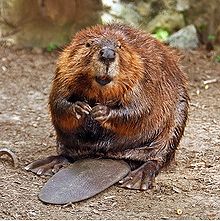For those who don’t know, Canada’s national animal is the beaver. At least, that’s what I was taught and have believed for many years, so you can imagine my surprise when I found out that Canada has a second national animal, the Canadian horse. I think the reason for the sudden appearance of a second national animal is perfectly obvious since the word ‘beaver’ has become a dirty joke.
This was brought sharply to mind the other day when I saw the headline, World’s biggest beaver dam discovered in northern Canada [in the province of Alberta], on physorg.com. It’s a pretty amazing dam, from the news item,
Researcher Jean Thie said Wednesday he used satellite imagery and Google Earth software to locate the dam, which is about 850 metres (2,800 feet) long on the southern edge of Wood Buffalo National Park.
Average beaver dams in Canada are 10 to 100 metres long, and only rarely do they reach 500 metres.
First discovered in October 2007, the gigantic dam is located in a virtually inaccessible part of the park south of Lac Claire, about 190 kilometres (120 miles) northeast of Fort McMurray.
Apparently, the beavers started on this project in the mid-1970s and many generations have worked on it. In fact, they are still building it. I wonder if one could describe it as a kind of beaver metropolis?
While I was meditating on these beavers and their dam, I remembered that Canada’s History magazine made this announcement in January 2010 (from a Reuters news article),
Canada’s second-oldest magazine, The Beaver, is changing its name because its unintended sexual connotation has caused the history journal to become snagged in Internet filters and has turned off potential readers.
The Beaver was founded in 1920 as a publication of the Hudson’s Bay Company, then a fur trader and now a department store chain. It has long since become a broader magazine about Canadian history and will change its name to Canada’s History with its April issue, editor-in-chief Mark Reid said on Tuesday.
When The Beaver started publication, the name evoked only Canada’s thriving fur industry.
Actually, it evoked a little more than just the fur trade. From this Wikipedia essay,
The beaver’s emblematic status originated from the fact much of Canada’s early economic history was tied to the fur trade in beaver fur, used to make hats fashionable in Europe. Another reason for the beaver’s status in Canadian heraldry is that it is symbolic of industry, due to its habit of constructing dams and lodges. [emphasis mine]
I remember the industriousness aspect largely because in grade one we were split into two groups, ‘busy bees’ and ‘??? beavers’. I was in the beaver group and somewhat miffed since I had (and have) a strong preference for alliterative phrases and ours (whatever it was) most definitely was not. As a murmur of protest rose (I was not alone in this), the teacher did note that beavers are just as hardworking as bees and Canada’s national animal.
Today, I’d like to take the word beaver back from sniggerers. After all, double entendres do change over time and I believe it’s time to rehabilitate this one. To encourage this, here’s a picture of the innocent animal,
The image was taken by Steve and is available at Wikipedia on this page. It is known as the North American Beaver (Castor canadensis). There are two types of beavers (North American and European) and they are genetically incompatible.

‘busy bees’ and ‘??? beavers’
Almost certainly `eager beavers’, which of course does nothing to dispel the risqué allusion.
Thanks! I just couldn’t think of it and, of course, the adjective in this context does nothing to support my case for taking the word back. Cheers, Maryse
Pingback: Apple IPad to Be Released in UK, Canada on May 28 – BusinessWeek - Most hotest, Most latest Sci/Tech News Online - Top Sci/Tech News Online – Online News 28
Given the mention of the fur trade and beavers in your blog, I wanted to let you know about my upcoming book, FUR, FORTUNE, AND EMPIRE: THE EPIC HISTORY OF THE FUR TRADE IN AMERICA (W. W. Norton, July 2010). I have a couple of chapters in the book on beavers. A video that gives an overview of the book can be found on YouTube at,
http://www.youtube.com/watch?v=gSNNoeUf4bA
You can also find out more about the book at my website: http://www.ericjaydolin.com. ;
Hello, Thank you for stopping by and I did take a look at the video on your website and tried, unsuccessfully, to find a table of contents for your ”fur’ book. Regards, Maryse